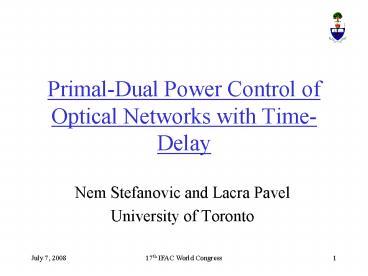PrimalDual Power Control of Optical Networks with TimeDelay - PowerPoint PPT Presentation
1 / 27
Title:
PrimalDual Power Control of Optical Networks with TimeDelay
Description:
Primal-Dual Power Control of Optical Networks with Time-Delay. Nem Stefanovic ... Paganini et. al. (2003) studies the primal-dual control of a single flow using ... – PowerPoint PPT presentation
Number of Views:51
Avg rating:3.0/5.0
Title: PrimalDual Power Control of Optical Networks with TimeDelay
1
Primal-Dual Power Control of Optical Networks
with Time-Delay
- Nem Stefanovic and Lacra Pavel
- University of Toronto
2
- Pictures of EDFAs
3
Where/Why Use Optical Networks
- Backbone of Internet
- More bandwidth than any other communication
medium - No external electromagnetic interference
4
Optical Network Operation
- Signal channels carried by light
- Channels are wavelength division multiplexed
(WDM) - Network delivers signal from one end of network
to other - Light has a propagation delay
5
Components of Optical Links
- Optical fibers transmit light
- WDMs Multiplex Channels
- EDFAs amplify signals, introduce ASE noise
6
Optical Link
EDFA
EDFA
EDFA
EDFA
WDM MUX
WDM DEMUX
7
Optical Link as a System
- Inputs are signal powers at sources
- Outputs are optical signal to noise (OSNR) values
at receivers - Link algorithm computes the channel prices based
on link utilization - Control algorithm at sources adjusts channel
powers for OSNR optimization
8
OSNR Model
ui(n) input power ith channel ?i,j jth noise
gain of ith channel output n0,i noise at Tx
9
OSNR Optimization as Nash Game
- Each channel w/ action ui is a player in a game
- Each player minimizes their own coupled, cost
function
- Ui is a coupled utility function
- u-i is the u vector without the ith entry
10
Utility Function
- ai channel dependent parameter
11
Control Algorithm
- ? channel price
12
Link Algorithm
- ? - channel price
- P0 - total link power, capacity constraint
- ? - step size
13
Interconnected System
14
Time-Delay in Optical Link
- ?fforward time-delay (transmitter-receiver)
- ?bbackward time-delay (receiver-transmitter)
- ? round-trip time, ?f ?b
?f
OPTICAL LINK
Input powers, ui (Tx)
Output OSNRi (Rx)
?b
15
Simplifying Assumptions
- Modify control algorithm to increase the
time-delay in ui(t) to ui(t-?) - Move link algorithm to the sources
- Increase time-delay of channel price ?(t) to ?(t
-?) in the control algorithm
16
Modified Block Diagram
17
Closed Loop System
where,
- zi ui-ui, x?-? ,, and ? is small
- .
18
Problem Statement
- Determine the conditions for stability of the
closed loop system for all time delays ? ? 0.
19
Research Context
- Paganini et. al. (2003) studies the primal-dual
control of a single flow using boundary layer
techniques. - Arcak et. al. (2004) use passivity and Lyapunov
techniques to study primal-dual and positive
projection gradient algorithms - A useful reference for Lyapunov time-delay
stability analysis in congestion control is
Niculescu et. al. (2003)
20
Stability Conditions
The closed loop system is exponentially stable if
and ? is small enough.
21
Steps of Proof
- Break up the closed loop system into its reduced
and boundary layer (Matrix) form - where the reduced system has no delay, and the
boundary layer system is linear
22
Steps of Proof (Continued)
- Analyze the boundary layer system via
Lyapunov-Razumikhin stability theory - or equivalently, set PI and ?00,
- which manipulates to the given time bound
23
Steps of Proof (Continued)
- Find Lyapunov functions for the reduced and
boundary layer systems - Sum the Lyapunov functions into a composite
function - Apply the composite Lyapunov function to the
closed-loop system
24
Simulation 1(?i0.1)
Design 10 OAs cascaded, delay10ms, OSNR
targets?23dB
25
Simulation 2 (?i0.54)
Design 10 OAs cascaded, delay10ms, OSNR
targets?23dB
26
Future Research
- Apply Lyapunov-Krasovskii theory instead of
Lyapunov-Razumikhin theory - Extend the theory from the single link case to
general network configurations - Improve the OSNR model to include time-varying
parameters
27
Thank You!































